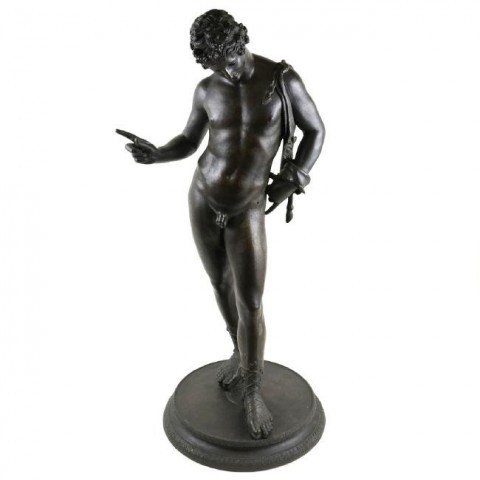Chiurazzi foundries were established by Gennaro Chiurazzi senior (1840), first apprentice and then worthy follower of Pietro Masulli, the Neapolitan famous sculptor who first conceived and put in practice the idea of copying the ancient works of art in their splendour, drawing his inspiration from Cellini's method.
He founded an art school in the Reale Ospizio dell' Albergo dei Poveri, situated in Naples, Piazza Carlo III, and through his hard work succeeded in endowing Naples with two permanent galleries for ancient art, the first in the Galleria Principe di Napoli, the second in Piazza dei Martiri.
In this way, all art lovers could be able to admire and buy in the splendid galleries copies of the ancient works from Pompei, Ercolano, Rome and all Italian museums. On the occasion of the World Exhibition in St. Louis (1900), Gennaro Chiurazzi senior's triumph so honoured Naples and Italy that the whole of the American press of that time gave a lot of space to write about him, singing hymns to his value.
Federico and Salvatore Chiurazzi continued their father's work in the most important period (1895 - 1939) which lasted until the Second World War. This age gave birth to the marble works, the ceramics, the monumental foundry, the traditional foundry and the foundry for the copying of classic works, and registered the highest number of workers, 600 highly skilled people, true artist in their field, who contributed to produce the greatest monumental works for all countries.
Among them, the Madonna del Carmine in Cuba, the equestrian group in General Artigas' honour in Montevideo, the works for th Carnegie Library College in Pittsburg, the Politeama Garibald's quadriga in Palermo, the Vittoriale's quadriga in Rome, the Viscount Caijru's monument in Bahia, the group "Civilisation and Science " in Panama, the Diaz's equestrian group in Naples.
The great development of the monumental foundry did not stop the primary and traditional activity of copying the classic works, which, instead, spread all over the world thanks to the demands coming from both private collectors and lovers and many Museums, such as those in London, Edinburgh, Cambridge, Aberdeen, Glasgow, Dublin, Cardiff, New York, St. Louis, Brooklyn, Boston, Baltimora, Chicago, Pittsburg, Kansas City, San Francisco and many other interested in showing in their galleries the copies of the masterpieces guarded in our Museums.
These reproductions' high quality and perfect fidelity, which were possible thanks to the prestigious work of artists who had been trained at the Chiurazzi's artisan school, brought to the continuous flow of demands from abroad. Only the crisis which the war caused in 1939 put an end to the splendour of that extraordinary period, which would have definitely lasted in a peaceful and harmonious world.
Federico's son, Gennaro Chiurazzi junior (1987),grown up in the others' shadow and matured during the best period found himself alone, at nearly 50 years old, in the very hard moment of the recovery, after the tragedy which had shocked the whole world.
The classic works' traditional foundry continued thanks to the unchanged seriousness and love for art of the third generation of workers.
To the Fonderia Chiurazzi belongs an exclusive gallery of plaster casts, a very famous and important collection of plugged plaster moulds produced copying the originals guarded in various Italian museums, from the statues in the Museo Nazionale in Naples to the statues in the Museo Vaticano, Museo Capitolino, Museo di Villa Borghese in Rome, to name the most famous.
Chiurazzi's gallery of plaster casts forms an extraordinary heritage which is absolutely necessary for the bronze reproducing of classic and modern works' exact copies, especially from the best 19th-century Neapolitan sculpture. This patrimony, the result of a 100-year work for the firm, is really exclusive and unique in the whole world, as today no authorisation at all is given from the competent Authorities for the bronze reproducing of the works exhibited in the various Italian museums.

